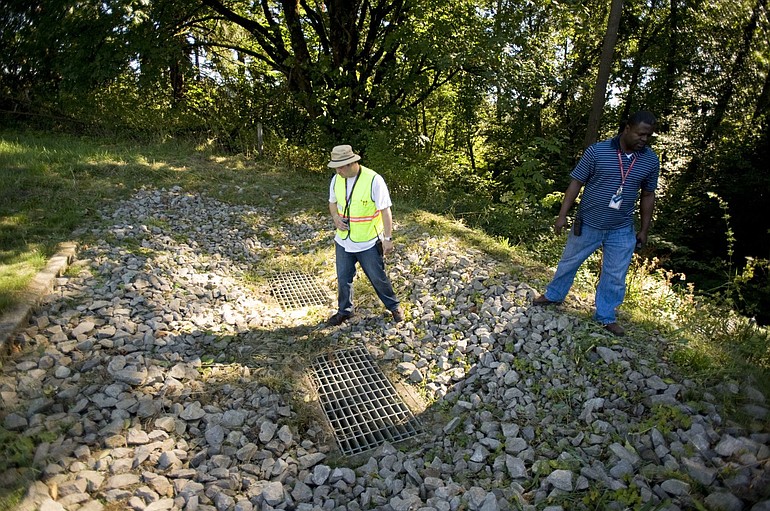o What: Salmon Conservation Fair — an art exhibit, conservation fair and lecture.
o Where: Administration Building, Washington State University Vancouver, 14204 N.E. Salmon Creek Ave.
o When: 4:30 p.m. Thursday.
o Special events: Idaho artist Eileen Klatt will display a selection of life-sized paintings representing one of 61 Columbia basin salmon or trout populations that are now extinct. Klatt will lead a painting demonstration from 4:30 to 6 p.m. in Room 130. In addition, local conservation groups will host informational booths. At 7 p.m., Klatt will join Battle Ground-area fish rescuer Dave Brown for a lecture and panel discussion on salmon conservation.
o Cost: Free.
o Information: Visit http://events.vancouver.wsu.edu/event/salmon-conservation-fair.
Don’t expect to see a salmon on the university campus in Salmon Creek.
Located on a former cattle pasture on an eastward-facing slope, most of Washington State University Vancouver’s 351-acre campus is situated well above the meandering course of Salmon Creek and its tributary of Mill Creek.
o What: Salmon Conservation Fair -- an art exhibit, conservation fair and lecture.
o Where: Administration Building, Washington State University Vancouver, 14204 N.E. Salmon Creek Ave.
o When: 4:30 p.m. Thursday.
o Special events: Idaho artist Eileen Klatt will display a selection of life-sized paintings representing one of 61 Columbia basin salmon or trout populations that are now extinct. Klatt will lead a painting demonstration from 4:30 to 6 p.m. in Room 130. In addition, local conservation groups will host informational booths. At 7 p.m., Klatt will join Battle Ground-area fish rescuer Dave Brown for a lecture and panel discussion on salmon conservation.
o Cost: Free.
o Information: Visit http://events.vancouver.wsu.edu/event/salmon-conservation-fair.
Yet, the campus recently earned distinction as a bona fide salmon-safe environment.
The campus includes an abundance of natural and man-made attributes — retention ponds, intact forest habitat, drought-resistant native shrubs — that collectively minimizes irrigation demand and filters every last drop of stormwater runoff before it can pass through the gills of a fish.
Salmon Safe, a Portland-based nonprofit organization, certified the campus last month.
Dan Kent, the organization’s executive director, said WSU Vancouver stands out from other college campuses in Oregon and Washington.
“A lot of the projects that we see are much more urban and landlocked away from any stream,” Kent said. “That campus is really an oasis of nature.”
That’s not by happenstance.
During a tour of the sprawling campus last week, grounds specialist John Benson and facilities operations director James Martin pointed out several areas where the 14-year-old campus goes well beyond minimum requirements of environmental regulators. Starting at the uppermost western edge of the campus, a 5-acre retention pond captures stormwater flowing down from the adjoining Mount Vista neighborhood. Standing water is obscured by plantings of cottonwood, hawthorn, vine maple, western red cedar, willow, cattails and juncus.
The pond, in turn, is surrounded by low-maintenance turf that doesn’t require irrigation or fertilizer.
Outside the core area of the campus, where maintenance workers will combat weeds with a small shovel or the occasional squirt of herbicide, Martin said workers concentrate on a lower-key approach to managing greenscapes. Workers don’t obsess about killing every last dandelion.
“We can live with ‘X’ amount of weeds,” Benson said.
Mowers may only pass certain areas of the campus once a year, or less. Rather than clipping the grass to golf course specifications, Benson said, maintenance workers might raise the mower deck by 6 inches to give native grasses and clover a chance to flourish.
For each drop of rain that hits a rooftop or roadway, Benson knows just where it will be pulled by gravity.
He knows that each droplet that overflows from the uppermost retention pond, for example, will wind its way through a small tributary cascading through a towering forest WSU has preserved on the southeast side of campus.
“It hits two ponds and a basin, a forest, and two more wetlands before that droplet of water ever gets to Salmon Creek,” Benson said. “If it ever gets there.”
Erik Robinson: 360-735-4551, or erik.robinson@columbian.com.



